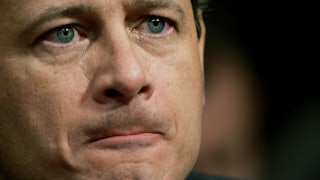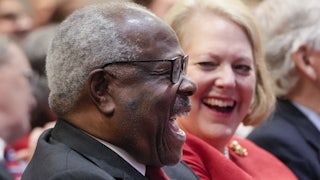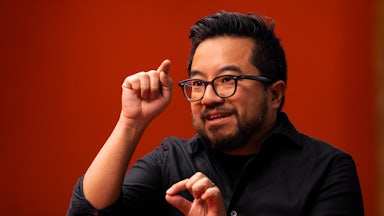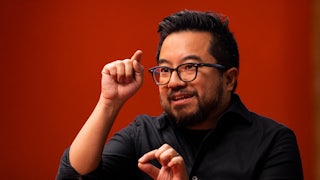Last week, ProPublica published a comprehensive investigation detailing Clarence Thomas’s quarter-century friendship with Harlan Crow, a billionaire megadonor for conservative causes and Republican candidates. Supreme Court justices do not live on some sort of judicial Mount Athos; they are allowed to have friends. But Thomas’s friendship with Crow is still a fairly unusual one, judging by ProPublica’s reporting.
For one thing, it appeared to violate statutory requirements for federal judges to report certain gifts they receive while in office. Thomas, in a statement on Friday, claimed that he had believed the trips fell under an exception for “personal hospitality.” Critics countered that this exception was not meant for $500,000 private flights to Indonesia, long vacations on Crow’s East Texas ranch, or other luxury junkets that might be otherwise unaffordable for a public servant.
The close bond between a Supreme Court justice and a billionaire donor might seem strange and possibly unethical to outsiders. But it makes perfect sense within the framework of the conservative legal movement. By the mid-twentieth century, the American legal establishment was generally liberal in its ideological outlook. So were most of the institutions that it controlled: courts, law schools, and even public-interest firms like the American Civil Liberties Union. Over the past few decades, right-wing lawyers and their backers have gone to great lengths to create a counter-elite of sorts among themselves in Washington.
The Thomas-Crow friendship is a useful window into how this web of social connections and political influence actually works in what conservatives see as hostile territory. While not necessarily corrupt, this practice is at odds with the neutral, distant figures that most Americans probably imagine judges to be. That is exactly the point.
Thomas is not the first conservative justice to have his personal connections closely scrutinized in recent months. The New York Times wrote last November about a surreptitious campaign by Bob Schenck, an anti-abortion reverend, to influence the Supreme Court justices. (Schenck later moved away from his previous views before sharing his activities with the Times.) He described his ministry-slash-lobbying-campaign, which began in 2000, to the Times as an effort to “embolden the justices” by exposing them to conservatives who would laud them as heroes for opposing Roe.
According to Schenck, he encouraged wealthy anti-abortion donors to join groups like the Supreme Court Historical Society to get up-close access to the justices whenever possible. While most of the justices rebuffed his efforts, Thomas and Antonin Scalia allowed him to visit the court’s chambers and joined him in prayers, some of which included coded anti-abortion messages. Schenck also claimed that, through two donors who dined socially with Justice Samuel Alito and his wife, he gained advance knowledge of the Supreme Court’s 2014 ruling on the Affordable Care Act’s contraceptive mandate. (Alito and the surviving donor denied Schenck’s allegations.)
To be fair, the conservative legal movement is not as monolithic as many of its opponents on the left assume. Members run the ideological gamut from anti-regulatory libertarians to corporate big-business lawyers to law-and-order prosecutors to Christian culture warriors. Like any ideological movement, it also has an overarching goal: to shift the American legal system further to the right by elevating conservative judges, advancing policy goals through litigation, building its legal ideology through scholarship, and cultivating the next generation of conservative lawyers. Common experiences like membership in the Federalist Society, service in Republican administrations, and activism in right-wing causes form a natural social network among the movement’s adherents.
At its highest levels, that social network also serves two conscious functions for the movement. First, it helps identify and filter out future job-holders, whether as top lawyers in a Republican presidential administration or as potential judicial nominees. This became mandatory in 1990 after George H.W. Bush nominated David Souter, a little-known First Circuit judge from New Hampshire. Rather than pushing the court further to the right after the retirement of Justice William Brennan, one of the court’s few remaining liberals at the time, Souter eventually drifted into the court’s liberal wing and became one of its most reliable members by the time he retired in 2009.
As I’ve noted before, the Souter experience—and, in particular, his role in keeping Roe v. Wade alive for another quarter-century—prompted legal conservatives to renew their emphasis on a future nominee’s ideological credentials. They had to do so in a way that wouldn’t tip off the general public and imperil their confirmation, as had happened to Robert Bork in 1986. Their emphasis on personal connections went through its first trial by fire in 2005, the next opportunity that arose for a Republican president to nominate a justice. Sandra Day O’Connor had retired at the beginning of the summer to tend to her husband who had been diagnosed with Alzheimer’s disease. William Rehnquist then died that August after a long battle with thyroid cancer.
George W. Bush initially nominated John Roberts to replace O’Connor; he renominated Roberts to become the next chief justice after Rehnquist’s death. Roberts, as I described in the magazine last year, was more or less a known commodity. He had worked in the Reagan Justice Department and was one of the many Republican lawyers who helped with the Bush-Cheney campaign’s litigation in Florida in 2000. He had friends and allies throughout the conservative legal movement; there were few doubts about how Roberts would align in the court’s ideological battles. The same couldn’t be said, though, for Bush’s next nominee that year: White House Counsel Harriet Miers, a longtime Bush ally from his Texas days without a significant legal paper trail.
Almost immediately, the Bush White House came under withering criticism from the conservative legal movement for nominating her. Democrats criticized the move as a sort of cronyism, but for legal conservatives, Bush had committed an even greater sin: She was not truly one of them. “Only a commitment to originalism provides a solid foundation for constitutional adjudication,” Bork, one of the movement’s founders, thundered in a Wall Street Journal op-ed. “There is no sign that she has thought about, much less adopted, that philosophy of judging.”
Miers eventually withdrew on another pretext, and Bush nominated Samuel Alito, who was part of the network, to fill the vacancy. The conservative legal movement had, in effect, set a precedent that it could veto Republican Supreme Court nominees that it didn’t truly know and therefore couldn’t trust. That veto is almost perfunctory today: The movement’s influence is so great that Leonard Leo, one of its leading figures, reportedly played an instrumental role in choosing some of the Trump administration’s judicial nominees himself. Leo is also a friend of both Thomas and Crow; the ProPublica report includes a picture of a painting of the three men together with other friends.
The second function of this social network is less well known and less obvious than the first. It is not enough to appoint conservatives to the Supreme Court; one must also ensure that they stay conservative. Paul Rosenzwieg, a former Bush Justice Department lawyer and a Heritage Foundation senior fellow at the time, summarized the movement’s problem in a 2005 column. He wrote in response to New York Senator Chuck Schumer, who reportedly claimed during an overheard phone call that year that Republicans had a pattern of choosing nominees who appeared conservative at first but proved to be more moderate after a few years on the court.
Rosenzweig agreed with Schumer’s analysis and disagreed only with some liberals’ explanation for why Republican Supreme Court nominees often drifted to the left. “Those looking for a more plausible answer need to look deeper,” he argued. “Justices change their views because they are people, and, at the core, people want to fit in. They want to be respected and liked by those whose opinions they value. Supreme Court justices come to Washington from around the country—Arizona, Illinois, New Hampshire, etc.—and soon are immersed in, indeed overwhelmed by, the sea of Washington elites.” Those Washington elites, he explained, tended to be broadly liberal.
He also noted that conservatives had even developed a term for this phenomenon since the 1990s: the “Greenhouse effect,” referring to Linda Greenhouse, the longtime Supreme Court reporter for The New York Times. That term was popularized by Judge Laurence Silberman, a conservative member of the D.C. Circuit Court of Appeals who criticized legal journalists for their perceived liberal bias in a 1992 speech to the Federalist Society.
“The truth is that the lawyer-reporters are among the most unbalanced, the least abashed, at asserting the value of judicial activism,” Silberman told the Federalist Society crowd, according to the Times’ contemporaneous report on the event. He later added: “It seems that the primary objective of the Times’s legal reporters is to put activist heat on recently appointed Supreme Court justices.” Silberman criticized other major news outlets as well but reserved most of his opprobrium for Greenhouse and for Neil Lewis, the Times’ legal affairs reporter.
Because of these influences, Rosenzweig wrote in 2005 that conservative judicial nominees had fallen into two camps. On one side were what he described as “philosophical conservatives” like Scalia and Thomas who are “committed to interpreting the Constitution as written and resistant to the ‘politically correct’ orthodoxy.” On the other side were nominees who turned out to be conservative only through “cultural predilection,” like Sandra Day O’Connor, which made them vulnerable to other influences after their confirmation. (Anthony Kennedy would later make a similar shift, though it was not fully apparent until after 2005.)
“That’s why conservatives want President Bush to nominate someone in the Scalia or Thomas mold,” Rosenzweig explained. “Conservatives have gotten their picks wrong before, and liberals want them to do it again. You’ll probably know who has carried the day as soon as the president names his selection. If it’s an ‘instinctive’ conservative, liberals will, once again, have lost the battle (when the nominee is confirmed) and won the war (when he or she ‘grows’). It takes only a little time in the nation’s capital for the Greenhouse Effect to work its magic.”
This perception of the court’s dynamics on the right—and their fear that their efforts to confirm a nominee would go awry—helps explain why conservatives use “betrayal” to describe moments when their side’s nominees depart from right-wing legal orthodoxy. Roberts became an apostate of sorts for his vote to save the Affordable Care Act in 2012, even though by any qualitative definition he remains a firmly conservative jurist. Justice Neil Gorsuch received a barrage of harsh denunciations from the right for his majority opinion in Bostock v. Clayton County in 2020, where he and the majority ruled that Title VII’s ban on workplace discrimination covers gay and transgender workers. It was not just that they thought he was wrong; it was that they thought he had broken some sort of trust.
Thanks to lifetime tenure, federal judges are largely immune to the typical tactics that conservatives might apply to Republican politicians who stray from the one true path. They have no campaign contributions to withhold and no primary challengers to fund. The Constitution is designed to make federal judges harder to pressure than the average public servant. But everyone needs friends. Humans are social creatures. We desire the approval of our peers and the respect of our colleagues. Judges are expected to resist these urges in the higher interest of the law. But they are not completely immune to them. They cannot be defeated in reelection, but they can be shunned and ostracized by those they respect.
There is a scene in the 2019 HBO series Chernobyl where the mild-mannered chairman of the KGB describes the Soviet secret police as a “circle of accountability” to the protagonist. “Yes, people are following you,” he tells Jared Harris’s character. “People are following those people. And you see them? They follow me.” Thankfully, the conservative legal movement does not use KGB tactics or methods. The general principle of ensuring ideological solidarity is nonetheless identical.
Thomas, for his part, hardly needs a social network to enforce his commitment to conservative legal principles. His long record of solo dissenting and concurring opinions shows that he is more comfortable than most people in going against the grain. I also do not doubt that he has a genuine friendship with Crow. People do not typically go on long vacations with someone they don’t like more than once, let alone for 25 years. But their relationship is nonetheless part of a broader social network that allows conservative legal figures to support and check each other as they navigate the liberal atmosphere of Washington, D.C., and the left-leaning pressures of modern society. Thomas’s participation helps strengthen and normalize it.
Thomas himself is also a key player and credential-maker in this network. As the court’s seniormost justice, he has now spent more than three decades building an influential network of former law clerks. Clerking on the Supreme Court is always a major career boost, but clerking for Thomas has reaped greater rewards than most in recent years. The Atlantic reported in 2019 that almost one-fifth of his former clerks either served in the Trump administration at that time or had been nominated by the Trump White House to a federal judgeship. His wife, Ginni, who was a conservative activist prior to their marriage, also holds positions in multiple conservative nonprofit groups throughout Washington, extending and cementing their influence in the legal counter-elite.
A good example of this network’s subtle reach can be found in a single tweet. In 2018, Trump nominated and the Senate confirmed former Thomas clerk James Ho to a seat on the Fifth Circuit Court of Appeals, deepening its already conservative character. Texas Senator Ted Cruz attended Ho’s swearing-in and posted a photo of it on Twitter. “Honored to attend Jim Ho’s swearing-in to the Fifth Circuit Court of Appeals today, alongside Justice Clarence Thomas & Judge Jerry Smith,” he wrote. “I am confident my good friend Jim will be an extraordinary appellate judge and a principled jurist faithful to the law.”
Cruz’s photo showed Ho taking the judicial oath in a sumptuous room with dark, rich wooden paneling. He and Thomas stood in front of a roaring fireplace and an ornate mantle that looked roughly the size of a Toyota Camry. A casual observer might have guessed that this room was in the Fifth Circuit’s courthouse or one of its judge’s chambers, perhaps Thomas’s own at the Supreme Court. ProPublica reported that it was actually Harlan Crow’s private library. The network prevailed.






